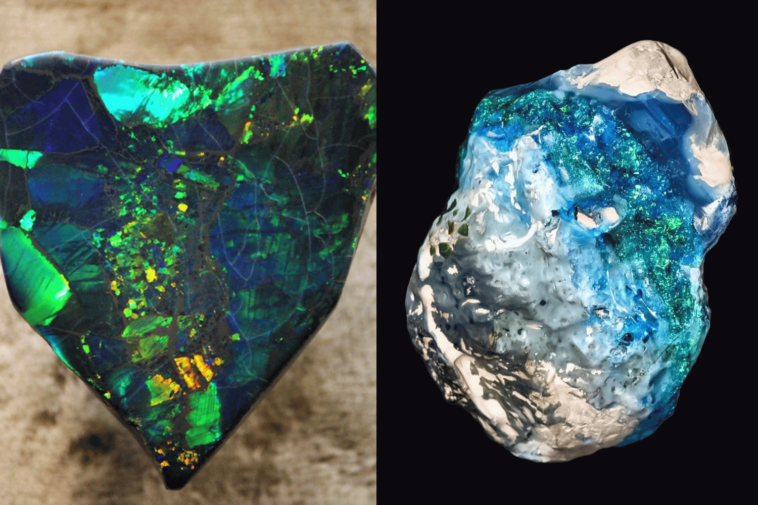Opals possess a captivating allure with their kaleidoscopic play of colors. They’ve enthralled gem enthusiasts and collectors worldwide for their ability to disperse light into a dazzling spectrum of colors. Throughout history, opals have been steeped in myths and legends, often associated with good fortune and considered a symbol of hope.
The appeal of opals is global, with some of the most magnificent specimens hailing from Australia, which is famed for producing over 90 percent of the world’s precious opals.
Below are some of the most famous opals in the world, which have garnered widespread attention among opal enthusiasts.
Aurora Australis
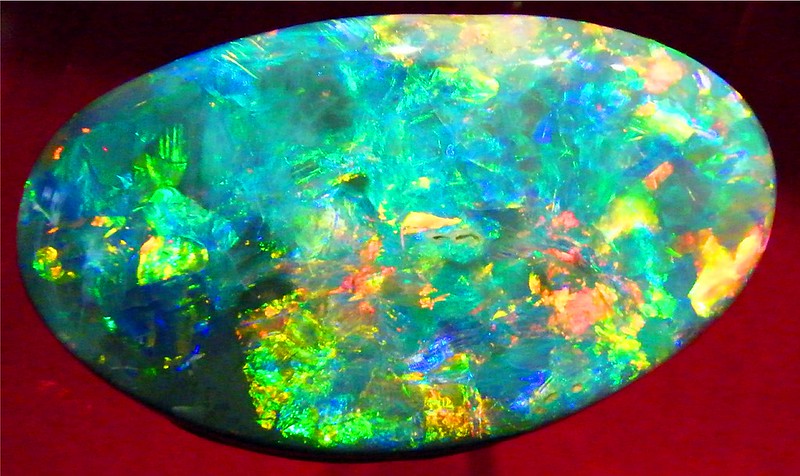
Discovered in 1938 at Lightning Ridge, the Aurora Australis is a black opal of unparalleled value and beauty. With an intricate harlequin pattern of red, green, and blue hues juxtaposed on a dark canvas, this gemstone is not only a visual spectacle but also a marvel in terms of its size. At a considerable weight of 180 carats and measurements of 3 by 1.8 inches, its scarcity is underscored by the intensity and vibrancy of its colors.
This opal’s deep connection to history is further exemplified by the natural starfish impression on its reverse side, a reminder of its origin in an ancient seabed. The magnificent Aurora Australis garnered a valuation of one million Australian dollars back in 2005.
Halley’s Comet Opal
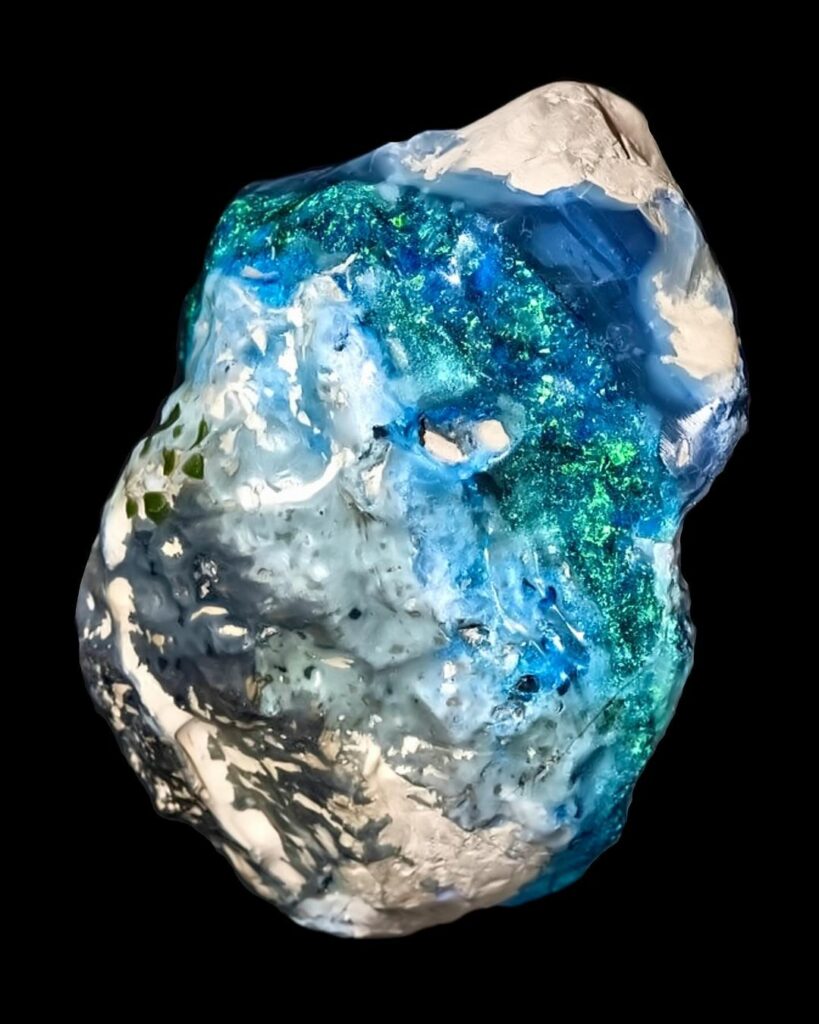
Halley’s Comet is recognized as the largest uncut black opal nobby on record. This exceptional stone was unearthed by The Lunatic Hill Syndicate during the period when Halley’s Comet was visible in the Australian night sky. Located at the Leaning Tree Claim in Lightning Ridge, the opal’s discovery coincided with its celestial namesake’s appearance.
- Weight: 1982.5 carats
- Dimensions: 100 x 66 x 63 mm (4 x 2-5/8 x 2-1/2 in)
- Color: Thick layers of gem-quality green and green/orange hues
In 2006, this magnificent gemstone held a price tag of AUD $1.2 million. To this day, it stands as the largest gem-quality nobby found in Lightning Ridge, showcasing a remarkable size and quality rarely matched by other opals.
Fire Queen
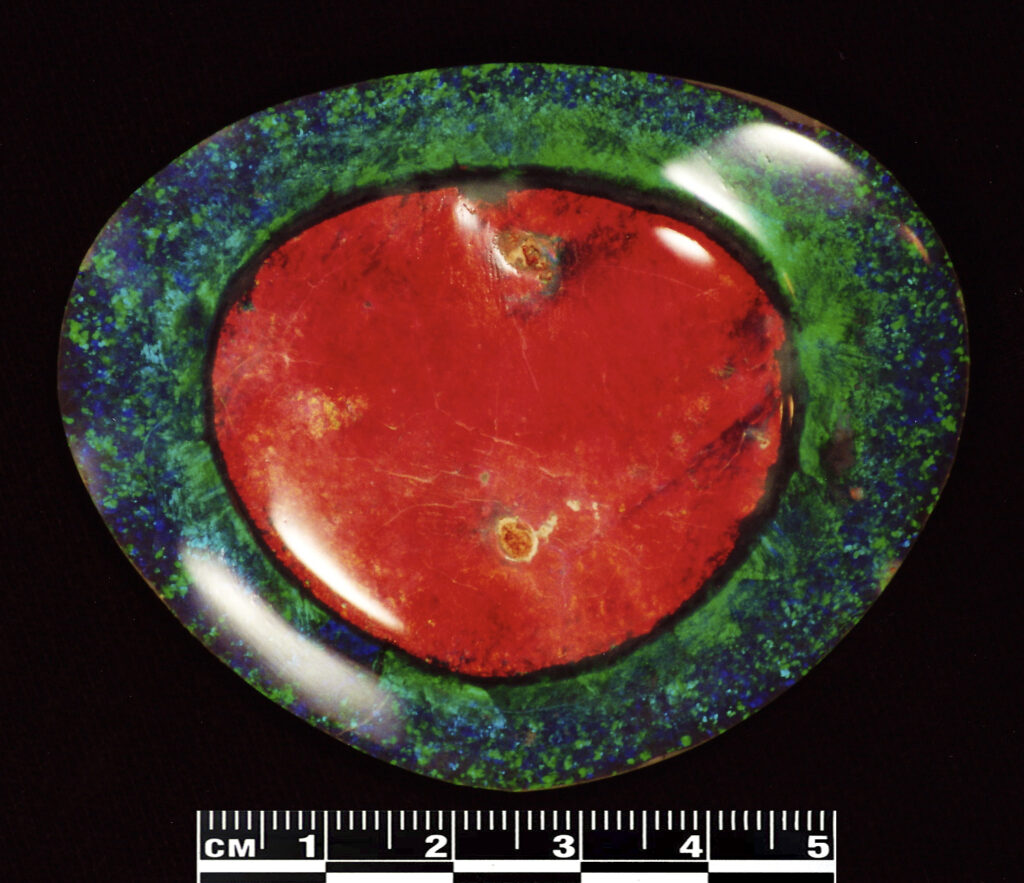
In the late year of 1906, Charlie Dunstan unearthed a remarkable opal at the Angledool Diggings, initially known as “Dunstan’s Stone.” It tipped the scales at an impressive 6.5 ounces (approximately 900 carats), earning a reputation as the largest nobby opal found by that time. Radiant with vibrant colors, this opal was beyond comparison.
Tragically, Dunstan sold this iridescent beauty for a modest sum of £100 during a visit to Angledool. It is rumored that afterward, he squandered two other significant opals while inebriated. Four years later, Dunstan’s body was discovered in his hut, his life ended by a self-inflicted gunshot.
Initially struggling to find a buyer due to the limited demand for large black opals, the gem eventually found its way to a museum in Chicago by 1928, where it was showcased with an estimated worth of £40,000. Now christened “The Fire Queen,” the stone caught the eye of J.D. Rockefeller in the 1940s, who purchased it for £75,000. It subsequently became part of the illustrious Rockefeller family collection.
The Black Prince
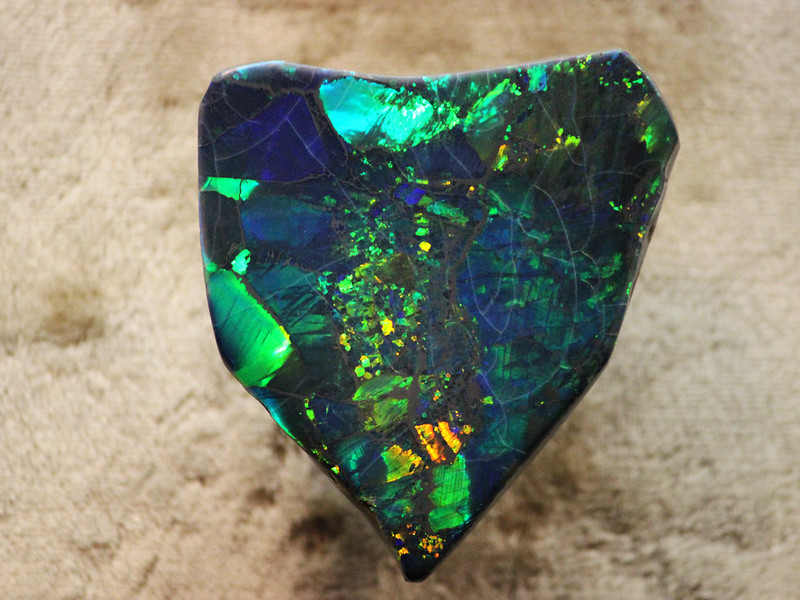
The gem known as “The Ebony Monarch” made its debut in 1915, unearthed from the Phone Line claim by a duo named Urwin and Brown. It’s an opal with a curious contrast in its appearance: one side showcases a striking flag pattern, while the opposite side is adorned in red. Despite a flaw—a sand hole right on its face—the stone still commands attention with its 181-carat heft.
A well-to-do American military man, while in England, took possession of this unique opal. It later found its way to the New York Museum of Natural History as part of a donation. Subsequently, the “Ebony Monarch” continued its journey to reside within the Forest Lawn Memorial Cemetery collection in Los Angeles. However, it shared a fate similar to the “Pride of Australia,” as both stones experienced the misfortune of theft.
In a display of familial affection and a knack for assigning grand titles, Bertha, Ernie’s sister, was the one to christen this stone along with “Flamingo,” “Pride of Australia,” and “Empress.” Collectively, these gems fetched an impressive sum of £2000 in the early 1920s when purchased by Sherman. At the time, the price was unprecedented for a quartet of black opals from the same Phone Line vein.
Olympic Australis
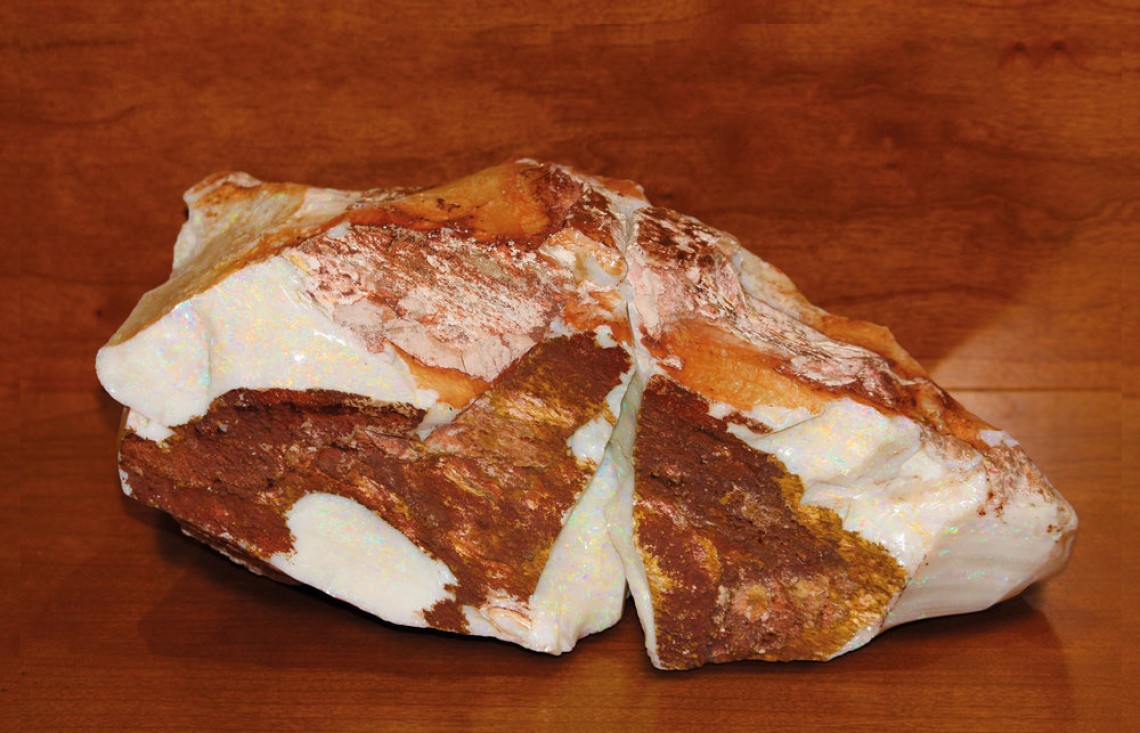
In the depths of the renowned Eight Mile opal fields of Coober Pedy, South Australia, the discovery of a remarkable opal took place in 1956. At about 30 feet underground, miners unearthed what became known as a marvelous opal specimen, tipping the scales at a massive 17,000 carats (3,450 grams). Measuring at an impressive 11 inches in length (280 mm), this gem stands 4¾ inches high (120 mm) and 4½ inches wide (115 mm), boasting an almost complete gem quality with a consistent coloration throughout its composition.
The gem was christened in tribute to the Olympic Games occurring in Melbourne during its unearthing and has later been assessed at a value of approximately 2.5 million Australian dollars back in 2005. Only a minor fraction of 1% of its weight is composed of the original earth still clinging to its surface. The purity and size of this opal suggest that it could potentially yield over 7000 carats if cut. Nonetheless, its unique character ensures that it remains unaltered, preserving the precious condition as it was discovered.
Butterfly Stone (The Red Admiral)
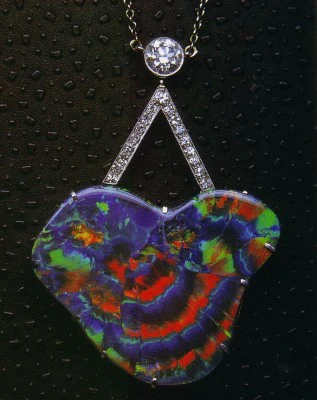
Discovered amidst the turmoil of World War I within the confines of the ‘Phone Line’ field, a remarkable opal weighing 51 carats was unearthed. This opal, which showcases a striking red pattern visible from all sides, has since captured the attention of gemstone aficionados around the world.
- Nickname: The Red Admiral
- Carat Weight: 51 carats
- Unique Quality: Displays a red pattern reminiscent of the Red Admiral butterfly
Renowned gemologist Len Cram commented on the stone’s captivating duality; a slight rotation transforms its appearance from a vibrant butterfly to a Spanish dancer donned in a ruffled dress, her posture and attire coming to life with fiery brilliance.
Ownership of this opal has changed hands several times, notably from Percy Marks to a noted Queensland cattle-rancher, eventually becoming part of the late Mrs. Drysdale of Sydney’s collection. As of the turn of the century, Percy Marks & Co. reassumed stewardship of this striking piece.
Pride of Australia (The Red Emperor)
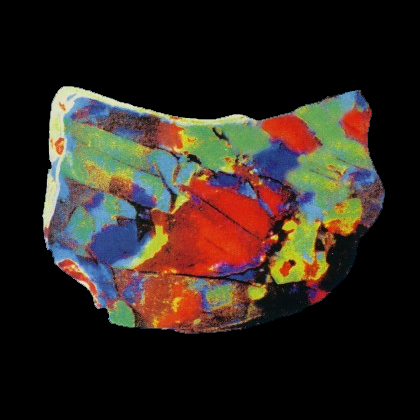
In 1915, the mining duo Tom Urwin and Snowy Brown stumbled upon a remarkable find near a then-known telephone cable area in Australia. Their discovery was no ordinary gem—it was an opal that mirrored the shape of Australia itself. Measuring at 2 inches by 3 inches, this opal’s surface danced with a mesmerizing pattern of black and blue veins, woven together with vibrant red flashes. Its unique colors and stature quickly earned it the title of Australia’s most exemplary opal.
The majestic opal, weighing in at 225 carats, was just small enough to be kept in a tobacco tin, a feature that added to its lore. It boasted two layers of color, with the underside presenting a lighter, almost checkered appearance contrasting the darker, richer colors of the main surface. By 1920, the opal, along with three companion stones, was purchased for a record-breaking £2000 by Ernie Sherman, marking the highest sum ever spent on black opals at the time.
| Dimensions: | 2″ x 3″ |
|---|---|
| Weight: | 225 carats |
| Acquisition Date: | 1920 |
| Acquisition Price: | £2000 |
| 1931 Valuation: | £2000 |
In the following years, the opal affectionately known as “Pride of Australia” travelled the world, gracing at least five World Fairs by 1954 and captivating audiences with its intense colors. Amidst its journeys, it was included in the Percy Marks Collection of Sydney, renowned for its extraordinary opal assemblage.
Dr. Hubert Eaton, a prominent figure in the memorial park industry in Glendale, CA, and an esteemed collector of rare gems, set his sights on this Australian treasure. In the 1950s, upon finding the opal in Percy Marks’ display window and learning it was not for sale, Dr. Eaton displayed a remarkable tenacity. In a persuasive and strategic move, he insisted that his purchase of several opals was contingent on the inclusion of the esteemed Australian gem. Successful in his endeavor, Eaton secured the opal for his prestigious collection. However, reports conflicted on whether he paid the rumored price of £150,000 or a sum closer to £50,000.
Unfortunately, this opal, celebrated for its awe-inspiring beauty and storied past, later faced a tragic fate. It was stolen from its last registered owner, the Forest Lawn Memorial Cemetery in Los Angeles, leaving a void in the collection where once sat a gem that encapsulated the essence of Australia’s natural beauty.
Other Notable Opals
Empress of Australia
In 1915, from the same area as its counterpart ‘Pride of Australia’, a striking black opal emerged, originally dubbed the ‘Kaleidoscope Queen’ before being renamed the ‘Tartan Queen’. Initially, this gemstone boasted dimensions of 3 by 2 3/4 by 2 1/4 inches in its uncut form.
Professionals worked to what is now a renowned black opal to enhance its fiery red patches, coming to light at an estimated weight of 500 carats. In a twist of events at a local tavern, the gem, lauded as the most vividly colored opal from the excavation site, fell and fractured into two pieces.
From the larger fragment, twin opals were crafted, each extending to 2 inches and tipping the scales at 20 carats. One fragment’s allure was further elevated by being transformed into an exquisite pendant designed by Ernie Sherman’s daughter. The remnant of the ‘Empress’, at a substantial 50-60 carats and sizing up to 1 3/4 by 1 1/2 inches, found its grace as the centerpiece of a sparkling necklace, encircled by a halo of dazzling diamonds.
Historical Gems from Lightning Ridge:
- Red Flamingo discovered in 1914
- 1918 witnessed the unearthing of Queen of Alexander
- The Harlequin Flame came to light in 1919
- Grawin Queen emerged in 1926
- 1928 was a notable year with Sunset Queen, Light of the World, and Pandora surfacing
- Queen of Australia made its debut in 1931
- Rainbow Stone dazzled observers in 1933

